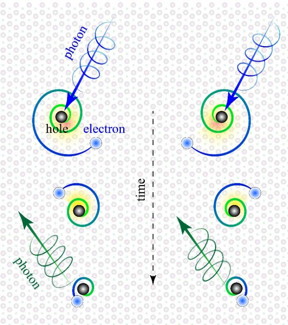Exotic spiraling electrons discovered by physicists: Rutgers-led research could lead to advances in lighting and solar cells
Rutgers and other physicists have discovered an exotic form of electrons that spin like planets and could lead to advances in lighting, solar cells, lasers and electronic displays.
It's called a "chiral surface exciton," and it consists of particles and anti-particles bound together and swirling around each other on the surface of solids, according to a study in the Proceedings of the National Academy of Sciences.

The two types of 'chiral surface excitons' are on the right and left side of the image. They are generated by right- and left-handed light (photons in blue). The excitons consist of an electron (light blue) orbiting a 'hole' (black) in the same orientation as the light. The electron and hole are annihilated in less than a trillionth of a second, emitting light (photons in green) that could be harnessed for lighting, solar cells, lasers and electronic displays.
Chiral refers to entities, like your right and left hands, that match but are asymmetrical and can't be superimposed on their mirror image.
Excitons form when intense light shines on solids, kicking negatively charged electrons out of their spots and leaving behind positively charged "holes," according to lead author Hsiang-Hsi (Sean) Kung, a graduate student in Physics Professor Girsh Blumberg's Rutgers Laser Spectroscopy Lab at Rutgers University-New Brunswick.
The electrons and holes resemble rapidly spinning tops. The electrons eventually "spiral" towards the holes, annihilating each other in less than a trillionth of a second while emitting a kind of light called "photoluminescence." This finding has applications for devices such as solar cells, lasers and TV and other displays.
The scientists discovered chiral excitons on the surface of a crystal known as bismuth selenide, which could be mass-produced and used in coatings and other materials in electronics at room temperature.
"Bismuth selenide is a fascinating compound that belongs to a family of quantum materials called 'topological insulators,'" said senior author Blumberg, a professor in the Department of Physics and Astronomy in the School of Arts and Sciences. "They have several channels on the surface that are highly efficient in conducting electricity."
The dynamics of chiral excitons are not yet clear and the scientists want to use ultra-fast imaging to further study them. Chiral surface excitons may be found on other materials as well.
Source: Nanotechnology Now
- 255 reads
Human Rights
Ringing FOWPAL’s Peace Bell for the World:Nobel Peace Prize Laureates’ Visions and Actions

Protecting the World’s Cultural Diversity for a Sustainable Future

The Peace Bell Resonates at the 27th Eurasian Economic Summit

Declaration of World Day of the Power of Hope Endorsed by People in 158 Nations

Puppet Show I International Friendship Day 2020

